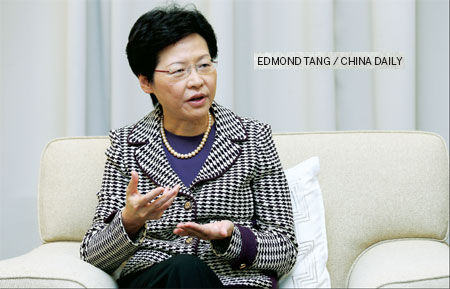Below and above the line
Updated: 2013-10-11 07:00
By Joseph Li(HK Edition)
|
|||||||
The Commission on Poverty has identified children from low-income households as the principal focus of special assistance programs, Chief Secretary for Administration Carrie Lam tells Joseph Li. She reiterates that the commission's guiding principles are to encourage employment and eliminate inter-generational poverty.
The government is planning additional measures to assist the poor, following last month's announcement by the Commission on Poverty setting a poverty line at 50 percent of the median household income in Hong Kong.
There also is a significant body of opinion favoring support for people marginally above the poverty line, since their living conditions are not much better than those below the line.
A low income supplement is in the pipeline, among other things. Full details will be announced in the coming months.
Assets and public rental housing are not taken into account in the evaluation of who is below the poverty line. Assets are hard to check, while public rental housing units cannot be considered disposable income.

"The setting of a poverty line for the first time in Hong Kong demonstrates the political commitment of the SAR government to tackle the rather deep-seated poverty problem in Hong Kong," Chief Secretary for Administration Carrie Lam Cheng Yuet-ngor told China Daily in an exclusive interview.
The poverty line has three functions, according to Lam, who also chairs the Commission on Poverty. Apart from grasping more accurately the characteristics of the population of impoverished people, the poverty line can help focus measures to ameliorate poverty and to evaluate the effectiveness of anti-poverty policies.
Social security aid
As projected, there were about 1.32 million poor people (540,000 households) in 2012. After taking into consideration of non-permanent cash relief such as social security and electricity allowance, the number was reduced to 1.02 million people, (400,000 households).
People in need fit into characteristic groupings readily identified, Lam observed. About one-third are elderly. About one-fifth (208,000) are children under 18.
About 300,000 households have not applied for social security, including 140,000 low income households that should be eligible for special assistance.
"They are what we call the working poor," she pointed out. "Although they have jobs and work rather long hours, their income is not enough to support the family despite the minimum wage protection because there are so many dependents in the family. About 84 percent are families with three or more members but there is only one bread-winner in each family."
Lam observes that about 300,000 elderly people living below the poverty line are retirees, many of whom own property but have no regular income. Lam acknowledged she was citing last year's statistics, prior to implementation of the Old Age Living Allowance this year. The benefits of the OALA have yet to be revealed in the statistics.
"Our next step is to study the viability of a low income supplement to help the working poor," she disclosed. "Unlike the social security that supports the jobless, single parents, etc, the guiding principle is to encourage people to find work. We do not encourage people without work to seek government assistance.
"With limited resources, I will accord higher priority to children to eliminate inter-generational poverty than to the elderly. Knowing that one-fifth of the city's children are living in poverty in a wealthy society like Hong Kong, do we need to help them more?
Healthy growth for kids
"Children have only one opportunity to grow up. If we do not give them extra help during their growing years, they will lose the chances to grow up healthily and move upward."
A number of social welfare agencies have submitted low income subsidy proposals, she said. Whilst the Oxfam Hong Kong proposal involves an annual recurrent expenditure of HK$1.7 billion, the value of the plan advanced by the Hong Kong Council of Social Service (HKCSS) is well over HK$4 billion.
"This is by no means a small commitment," she said. "We have asked all the agencies to submit their proposals. The government will consider and blend them, hoping to come up with a financially viable plan acceptable to the agencies."
She anticipates that Chief Executive Leung Chun-ying will announce full details in his next Policy Address in January 2014.
"These measures can be considered homework for the second term after the poverty line is drawn as the homework for the first term," she said smiling in response to a comment by Christine Fang, HKCSS chief executive officer.
Lam reiterated the government will assess the effectiveness of the poverty amelioration measures based on whether the poor population decreases in numbers next year. However, she has not set fixed targets.
"Poverty alleviation is not the same as fixed targets," she said. "If we set a hard target of decreasing the poor population from 1.02 million to say 0.8 million, it will confine us to helping only those below the poverty line but ignoring those slightly above the line."

(HK Edition 10/11/2013 page8)